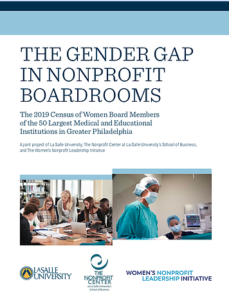Report details the gender gap on boards of Philly’s nonprofit meds and eds
 October 7, 2019
Category: Featured, Purpose, Short
October 7, 2019
Category: Featured, Purpose, Short
“We are not currently where we need to be in bringing the best possible resources to our governance tables.”
With those words Dr. Colleen Hanycz, the president of La Salle University, introduces the first of what is planned to be a triennial census of women on the governing boards of the 25 largest 501(c)(3) healthcare institutions and the 25 largest 501(c)(3) institutions of higher education in the Greater Philadelphia region.
A joint project of La Salle University; the Nonprofit Center at La Salle University’s School of Business, and the Women’s Nonprofit Leadership Initiative, the report is focused on the 50 largest nonprofit meds and eds in part because the revenues and number of people employed by those organizations significantly exceed those of the for-profit companies that have been the subject of similar reporting in the city.
“Stakeholders in the nonprofit meds and eds should be motivated by the same interest that motivates for-profit shareholders,” says the report, “the evidence showing that board diversity benefits corporations by improving governing processes, and bringing important varied perspectives to decision-making and improving outcomes.”
The report breaks down the representation of women on boards along several axes. It shows that the boards of the 25 healthcare institutions average 28% women — which is below the state legislature’s minimum goal of 30%. The 25 higher education institutions fare better, and exceed the minimum — but just barely — at 33%.
Not surprisingly, some of the best representation can be found at institutions that were either founded by women, or a women’s religious order: Doylestown Hospital, Cabrini and Immaculata universities and Bryn Mawr College.
The report includes some information about the racial composition of the boards. For example, we learn that the meds and eds boards have the same low percentage of people of color (13%), and that both sets of boards follow the same pattern: white men in the majority at 59-65%, followed by white women in the 22-28% range, with men of color 7-8%, and finally women of color, who don’t break 6% (see our infographic for the specific numbers).
The next report of this type would be well served by a more consistent examination of the composition of the boards. For example, there is no information about whether any of the women who are board chairs are women of color. Where the report was able to connect the dots to show that the boards with a woman chair had a highest number of women members as a consequence, it cannot do the same in terms of people of color because the data collected is not robust enough.
Hanycz called upon “fellow presidents and CEOs, along with the regional board leaders in the health and higher educational sectors” to look at the data and ask themselves what they could do to “ensure a more representative approach to answering the big questions of the day.”
The report ends with a series of calls to action, not only for meds and eds stakeholders, but also for foundations and funders, news media and community organizations.
Carmen Febo San Miguel, the executive director of Taller Puertorriqueño, read the report over the weekend and said she felt it drove home the need to continue working to make boards more representative.
“From my perspective this report documents, that although women have gained in the percentage of representation on the boards of the large nonprofits, that representation still falls short,” she said, “despite the evidence pointing to the benefits of diverse boards when compared to non-diverse boards in better decision-making.”
“As a woman and as a Latina,” Febo added, “it hits me twice, since the data also demonstrates that ethnic diversity falls even shorter. There is much more work to be done to continue to push the needle so boards, particularly of public institutions, are more representative of the communities they serve.”
Read the full reportTrending News











